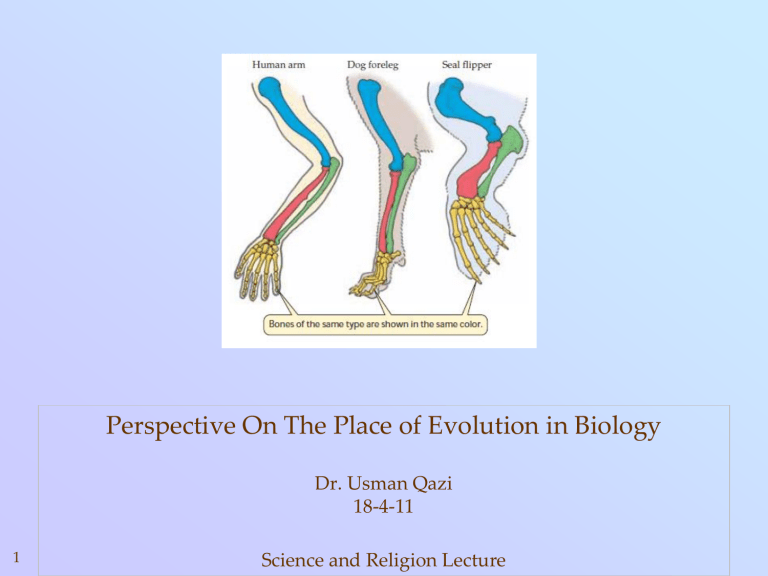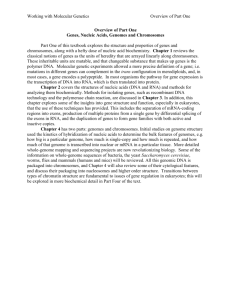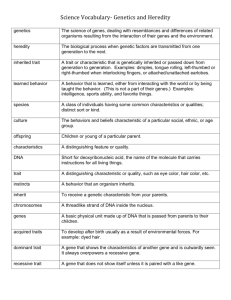Theory of Evolution – Lecture Slides (Prof. Usman

1
Perspective On The Place of Evolution in Biology
Dr. Usman Qazi
18-4-11
Science and Religion Lecture
2
…From so simple a beginning endless forms most beautiful and most wonderful have been, and are being, evolved”
(Origin of Species).
“There are more things in heaven and earth, Horatio, than are
dreamt of in your philosophy” (Hamlet, act 1, scene V).
3
4
Underlying Biology
Unifying Principles of Biology
Fundamental organization of living organisms
1. Cell are the basic units of life
- Immediate impact on pathology (cellular origin of disease)
- Counter example: Viruses (still need cells to replicate)
2. New species and inherited traits are the product of evolution
3. Genes are the basic unit of heredity.
4. An organism regulates its internal environment to maintain a stable and constant condition
5. Living organisms consume and transform energy.
6
Primacy of Information: Sequence Determines Structure
• DNA is the material of heredity
Each strand is a linear sequence made of four nucleic acids (A, C, G, T) joined to a backbone
–Strands are paired via specific attractive forces (A – T and G – C)
• Either strand can be the coding strand for a gene
• A gene has two portions:
(a) control region and (b) coding region
– Coding region makes an RNA transcript (of nucleic acids)
–Levels of transcription are modulated via the control region
• External signals or gene products can interact with control regions of other genes as transcription factors, and activate or inhibit them.
• In eukaryotes, not all DNA is transcribed
7
Primacy of Information: Sequence Determines Structure
• DNA is the material of heredity
Each strand is a linear sequence made of four nucleic acids (A, C, G, T) joined to a backbone
–Strands are paired via specific attractive forces (A – T and G – C)
• Either strand can be the coding strand for a gene
• A gene has two portions: (a) control region and (b) coding region
– Coding region makes an RNA transcript (of nucleic acids)
–Levels of transcription are modulated via the control region
• External signals or gene products can interact with control regions of other genes as transcription factors, and activate or inhibit them.
• In eukaryotes, not all DNA is transcribed
8
Primacy of Information: Sequence Determines Structure
• DNA is the material of heredity
Each strand is a linear sequence made of four nucleic acids (A, C, G, T) joined to a backbone
–Strands are paired via specific attractive forces (A – T and G – C)
• Either strand can be the coding strand for a gene
• A gene has two portions: (a) control region and (b) coding region
– Coding region makes an RNA transcript (of nucleic acids)
–Levels of transcription are modulated via the control region
• External signals or gene products can interact with control regions of other genes as transcription factors, and activate or inhibit them.
• In eukaryotes, not all DNA is transcribed
9
RNA transcript is used to make a protein.
DNA: ACGT
RNA: ACGU;
Genetic code: codons in RNA transcript code for all 20 amino acids
10
‘Central Dogma’: DNA
→ mRNA
→
Protein
How do molecular events organize multitudes of cells into specific body parts
(leaf, flower, bone)?
Using switches called transcription factors
Example of gene expression during development
BMP4 instructs cells in webbing of the developing foot to undergo programmed cell death
13
14
Challenge: Classify organisms
Morphology, embryology played a fundamental role
Comparison of DNA sequences has revolutionized classification
Main branches of the three of life
• Eukaryotes
(karyon: kernel = nucleus)
–Cells have internal compartments
• Prokaryotes
–Smaller than typical eukaryotes
–Genetic material is not compartmentalized
• Archaea
–- Unicellular organisms that appear closer to eukaryotes based on molecular sequences
15
Example of a highly conserved protein: Cytochrome c
• Chickens and turkeys have identical sequence homology (amino acid for amino acid)
–Ducks possess molecules differing by one amino acid.
• Humans and chimpanzees have the identical molecule, while rhesus monkeys share all but one of the amino acids.
• Pigs, cows and sheep also share identical cytochrome c molecules.
16
Evolution
History of Theories Explaining Evolution
Jean Baptiste de Lamarck (1744-1829), Zoological Philosophy
Individuals change due to environmental influences. These acquired changes are then passed on to offspring. Thus, the diversity of organisms is a result of organisms adapting to the environment because of individual needs.
Example: Giraffe necks, blacksmith arms
Theory was based on observations. Ideas of genetics and heredity came later.
Alfred Russell Wallace (1823-1913), On the Tendency of Varieties to Depart Indefinitely from the Original Type.
Useful variations will tend to increase, unuseful or hurtful variations to diminish.
Changes in species are not adaptations to their environment.
Instead, some qualities of an individual may allow it to outlive others [Survival of the fittest].
Charles Darwin (1809-1882), On the Origin of Species.
Used own observations, understanding of embryological and physical similarities among animals, their geographical distribution, geological record.
Also referred to co-adaptation between two species and a study of artificial selection/selective breeding.
Species do not arise independently; but are rather descendents of other species.
18
History of Theories Explaining Evolution
Jean Baptiste de Lamarck (1744-1829), Zoological Philosophy
Individuals change due to environmental influences. These acquired changes are then passed on to offspring. Thus, the diversity of organisms is a result of organisms adapting to the environment because of individual needs.
Example: Giraffe necks, blacksmith arms
Theory was based on observations. Ideas of genetics and heredity came later.
Alfred Russell Wallace (1823-1913), On the Tendency of Varieties to Depart Indefinitely from the Original Type.
Useful variations will tend to increase, unuseful or hurtful variations to diminish.
Changes in species are not adaptations to their environment.
Instead, some qualities of an individual may allow it to outlive others [Survival of the fittest].
Charles Darwin (1809-1882), On the Origin of Species.
Used own observations, understanding of embryological and physical similarities among animals, their geographical distribution, geological record.
Also referred to co-adaptation between two species and a study of artificial selection/selective breeding.
Species do not arise independently; but are rather descendents of other species.
19
History of Theories Explaining Evolution
Jean Baptiste de Lamarck (1744-1829), Zoological Philosophy
Individuals change due to environmental influences. These acquired changes are then passed on to offspring. Thus, the diversity of organisms is a result of organisms adapting to the environment because of individual needs.
Example: Giraffe necks, blacksmith arms
Theory was based on observations. Ideas of genetics and heredity came later.
Alfred Russell Wallace (1823-1913), On the Tendency of Varieties to Depart Indefinitely from the Original Type.
Useful variations will tend to increase, unuseful or hurtful variations to diminish.
Changes in species are not adaptations to their environment.
Instead, some qualities of an individual may allow it to outlive others [Survival of the fittest].
Charles Darwin (1809-1882), On the Origin of Species.
Used own observations, understanding of embryological and physical similarities among animals, their geographical distribution, geological record.
Also referred to co-adaptation between two species and a study of artificial selection/selective breeding.
Species do not arise independently; but are rather descendents of other species.
20
Darwin’s challenge: Why do new characteristics not get blended?
Answered by the Modern Synthesis (Genetic Mechanisms, Observation)
Evolution is gradual: small genetic changes, recombination ordered by natural selection.
Natural selection is by far the main mechanism of change; even slight advantages are important when continued.
What gets selected is the phenotype in its surrounding environment.
21
Types of selection in a population with a distribution of phenotypes
22
Artificial Selection: Plant Breeding
23
Speciation Reproductive
Incompatibility
24
25
Concepts Emerging Following the Modern Synthesis
• Large-scale geophysical events influenced evolution.
• Origin of the eukaryotic cell: Symbiosis with bacterial and archaean cells, which gave rise to compartmentalized structures.
• Tree of life- Now routine
• Evo-Devo
• Fossils- Feathered dinosaurs and flatfish
• Point mutations, gene duplication, horizontal gene transfer
Natural Selection: Convergent vs. Divergent Evolution
26
27
Life has shaped the planet’s atmosphere
Evolutionary Developmental Biology
Development consists of growth, differentiation, and morphogenesis
Organism development: Process of progressive changes, taking on the successive forms that characterize the life cycle.
In some cases, development only ceases with death.
- Growth (increase in size): Cell division or cell expansion
- Determination (Allocation of destiny). Differentiation: Specialization of cells.
- Morphogenesis: Shaping of the multicellular body and its organs.
Endless Forms
30
Hox genes control development along the anterior
–posterior axis
Example of gene expression during development
31
Development uses the same sets of genes throughout the animal kingdom
32
Evolution: Changes in expression patterns of developmental genes
33
34
Creation of order
Non Equilibrium Processes Can Create Order
With ‘Biological’ Characteristics
Bénard Instabilities (1900)
Set up a layer of liquid, e.g. water, between two parallel planes
• When temperature of top and bottom planes is equal
• At a specific
T hexagonal convection cells of characteristic dimensions appear.
• Phenomenon depends on ascending and descending currents
(amplified by buoyancy), opposed by fluid’s viscosity.
Macroscopic order results from an interplay of close-range intramolecular forces
• Self organisation occurs a consequence of being away from equilibrium.
• Hot fluid parcel rises, cools, moves sideways, and sinks in a certain direction of rotation.
• First cell arises randomly at specific
T. Its rotation influences the next cell that forms.
• The characteristic dimension of a cell is ~1 mm in a petri dish.
–In contrast, the range of intermolecular forces is 10 -10 m.
A reaction with spreading and interacting spirals that mimics life
38
Formose polymerization reaction in aqueous solution can give rise to sugars like ribose and glucose
Red regions in the spiral arms represent infrared emissions from dustier parts of the galaxy where new stars are forming.
Formaldehyde
(methanal)
Can form from
CO
2 and light
39
Puzzle: Life uses stereospecific molecules.
L-amino acids and D-sugars.
Is the early history of the creation of life even knowable?
Other Unknowables
Undo-able
• Unsolvable problems from
Euclid’s Elements :
1. Trisect of a given acute angle;
2. Double a cube;
3. Construct of a square of area equal to that of a given circle.
Only instruments allowed are the straight edge and the compass.
Impossible
Construct a Platonic solid other than
1. Tetrahedron (sides are triangle)
2. Hexahedron (sides are squares)
3. Octahedron (sides are triangles)
4. Dodecahedron (sides are pentagons)
5. Icosahedron (sides are triangles)
• Exactly solve the three-body problem
–However, planets are able to
'compute' their own paths
• Explain quantum mechanics in terms of causality
40
Is an apologetic attitude even needed?
42
43
Developmental Biology
What causes differentiation and morphogenesis?
•Experiment (1910): Transplant fragments of a newt embryo in different locations.
–Redifferentiation
–Hypothesis: “Fields" of cells producing organs such as limbs, tail and gills.
•Discovery of DNA
–All the information for development is in every cell
–Master control genes get turned on or off, affecting the developmental fate of a cell
–Field notion rejected
•But… Now we know that different mutations can cause the same malformations
–So they affect a complex of structures as a unit
–Rebirth of field?
Model Organism: C. elegans
Developmental Potential in Early Frog Embryos
Much of development is controlled by molecular switches that allow a cell to proceed down one of two alternative tracks
Developmental biology is essentially about understanding these switches
Plants have organ identity genes
Morphogen gradients provide position information to cells
A signal, called a morphogen, diffuses from one group of cells down a body axis, setting up a concentration gradient.
For a a signal to be a morphogen:
• It must directly affect target cells, rather than triggering a secondary signal that affects target cells.
• Different concentrations of the signal must cause different effects.
Example- development of the vertebrate limb
• The limb develops from a round bud.
• A group of cells where the bud joins the body wall, makes a morphogen called
BMP2 (bone morphogenetic protein 2)
–BMP2 gradient determines the anterior–posterior (“thumb to little finger”) axis of the developing limb.
• Highest dose of BMP2 -> thumb
–Smallest -> little finger.
Morphogenic axes in the fruit fly
•Both worms and flies are segmented
•However, flies have very distinct segments
•First requirement in development (making a fly from an embryo):
–Define the polarity of the embryo
•(Anterior-Posterior and Dorsal-Ventral axes)
Fruit fly maternal effect genes encode morphogens that determine polarity
• Maternal effect genes are in the mother’s ovarian cells, which surround and nurture the developing egg
• Gene products are delivered to to specific regions of the egg as it forms
• Mutants missing thorax bicoid gene produce larvae with no head or
–Those missing nanos have missing abdominal segments
54
‘Central Dogma’
Led to foundation of molecular biology.
DNA is a highly stable molecule, while RNA is unstable
“ The central dogma of molecular biology deals with the detailed residue-byresidue transfer of sequential information. It states that information cannot be transferred back from protein to either protein or nucleic
acid.” - Francis Crick
1 st Synthesis of the Mechanism of Evolution:
Natural Selection and Genetic Drift
• Darwin’s analysis entirely depended on morphology. • The complete set of observable traits that
• Challenge: Explain why do new characteristics not get blended?
make up the structure and behaviour of an organism is called its phenotype.
Mendel noted that inherited traits are expressed in an organism as per laws founded in probability:
– (1/4 chance of getting blue eyes from a cross between brown-eyed and blue eyes parents).
• Inherited traits are controlled by genes
• The complete set of genes within an organism's genome is called its genotype.
• A combination of alleles is the genotype.
• Frequencies of a llele and genotype s in a population remain constant
• Unless specific disturbing influences are introduced.
• Such as non-random mating, limited population size, mutations, selection, and other exceptions include intragenomic conflict.
55





![Instructions for BLAST [alublast]](http://s3.studylib.net/store/data/007906582_2-a3f8cf4aeaa62a4a55316a3a3e74e798-300x300.png)

